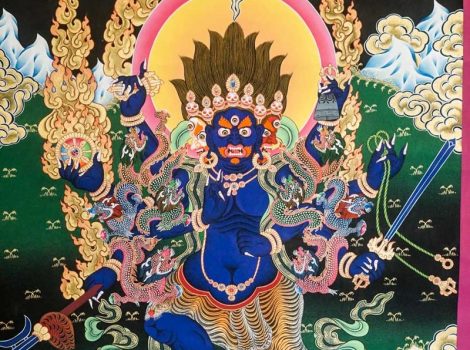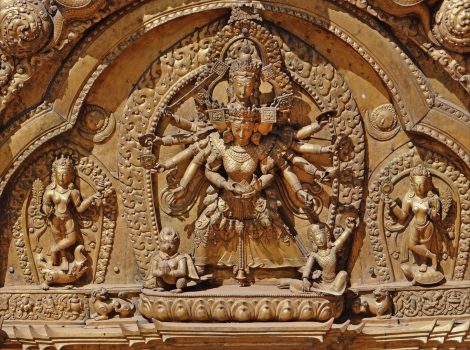
The age old tradition
This tradition is some what a love story of humans and gods, which is not new in the Hindu mythology.
Every year, four days before the 48-feet tall chariot of the scarlet god, worshipped across the Kathmandu Valley as Karunamaya, is pulled to Jawalakhel from Thati, the Jala Paneju (the priest who sits to the right of Machhindranath in the chariot) walks barefoot from Patan to Pyanga Thaa to offer the deity’s flowers and Prasad to the woman Yaaka Misa to fulfil a promise made centuries ago and to uphold the ceremonial link Lalitpur has with Kirtipur. How this tradition began and for what purpose.
Surely, as fascinating as the chariot , the myth or for real the incitation of the ritual is more fascinating.

The creation of the Rato Machindranath
As per the myth, it is said that King Narendradev of Bhaktapur, tantric master Bandhudatta of Kathmandu, Rathchakra jyapu of Lalitpur and Karkotak Nagaraj of Taudaha together brought the Rato Machhindranath idol from Kamakhya Peeth based in Assam, India, and started the chariot festival, thus, bringing rain to the Kathmandu valley.
The myth goes that a severe famine that lasted for 12 years ended upon the arrival of the god. Then, in the field, the paddies began to sway representing the prosperity that came with the idol, the god of rain. Then also began the chariot festival.

People from Assam, Kathmandu, Bhaktapur, Kirtipur and Lalitpur, who were involved in the process, started conducting various chariot festivals under their own names, except for one–Karkotaka. When they were on their way to take the idol, Karkotaka Nagaraja of Taudaha helped others cross the river by taking a form of a bridge. So, without him, it would have been almost impossible for others to bring the idol to Kathmandu.
Rage of Karkotak
In spite of his role, when no jatra was held under his name, Karkotak Nagaraj got angry for being left out. He managed to control his anger, but his wife, Nagarani, could not control her anger. While the jatra was going on, she disguised herself as a human and reached Thatitol of Lagankhel to take the Rato Machhindranath idol with her.
The next day, after dropping the tradition of dropping a coconut from the chariot, Nagarani tried to pull Machhindranath’s chariot with her full strength and take it away. No one dared to challenge her or her power first.

But Acharya Bandhudatta stopped the chariot from moving with his tantric power. And no matter how hard Nagrani pulled, the wheels of the chariot tied to Bandhudatta’s tantric spells did not budge. When Nagrani felt she would not succeed, she tricked Bandhudatta and took one of the deity’s 32 traits and fled away.
Nagrani wanted to go straight to Taudaha and disappear. Had that happened, it would have been impossible to search for her and bring back what she stole. It was again thanks to Acharya Bandhudatta and his tantric knowledge that he deceived Nagrani into climbing the hill of Kirtipur, and did not let her go to Taudaha.
Nagrani arrived at Pyanga Thaa in Kirtipur all tired. Acharya Bandhudatta followed her there and persuaded Nagrani into giving the stolen trait back, saying, “Oh Nagrani, the glory of Rato Machhindranath will be incomplete even if there is just one trait missing. So please return it to me.”
But, Nagarani did not agree.
Seeing Nagrani, Bandhudatta proposed, “Oh Nagrani, if you return that, I promise that every year the chariot festival from Lagankhel to Jawalakhel will be in the name of Kirtipur. And I will bring the prasad and offer it to a kumari or Yaaka Misaa (virgin girl) too.”
Honouring the tradition, and harmony of the two cities, girls from Kirtipur also reach Lalitpur to pull the chariot from Lagankhel as another part of the tradition called Yaaka Misaaya Bhujya.
After the two promises, Nagrani finally agreed to return the stolen trait to Bandhudatta. Even today, as per the story, the journey from Lagankhel to Jawalakhel is called Kirtipur’s rath yatra (chariot festival), which is dedicated to Yaaka Misaa of Kirtipur.
Since then,
Every year, from the Thatitol of Lalitpur, as a representative of the Rato Machhindranath, a paneju (priest) walks barefoot to Kirtipur to give offerings to Yaaka Misaa. Four days before the Rato Machhindranath’s chariot festival commences, there is a tradition that priests sit on the patio made at Sohrakhute in Mangal Bazaar. After looking at the stars and their astronomical calculations, they decide an appropriate sait (auspicious time) for jalpaneju to take the prasad to Yaaka Misaa in Kirtipur.
Yaaka Misa
The Yaaka Misa is a living divinity believed by the people of Kirtipur to be the spouse of Bunga Dyo, the native name for Rato Machhindranath. She is supposed to represent the wife that Machhindranath left in the city with the promise to send her ritual items as mementoes every year on a specific day during his chariot festival.
A woman from a Maharjan family of Pyanga Thaa, located in a courtyard a short distance from the Uma Maheshwor Temple in Kirtipur Municipality, fulfils this role and, as a requirement, remains unmarried her whole life.
The present Yaaka Misa, which means ‘single woman’ in Nepal Bhasa, is 73-year-old Laxmi Kumari Maharjan.






